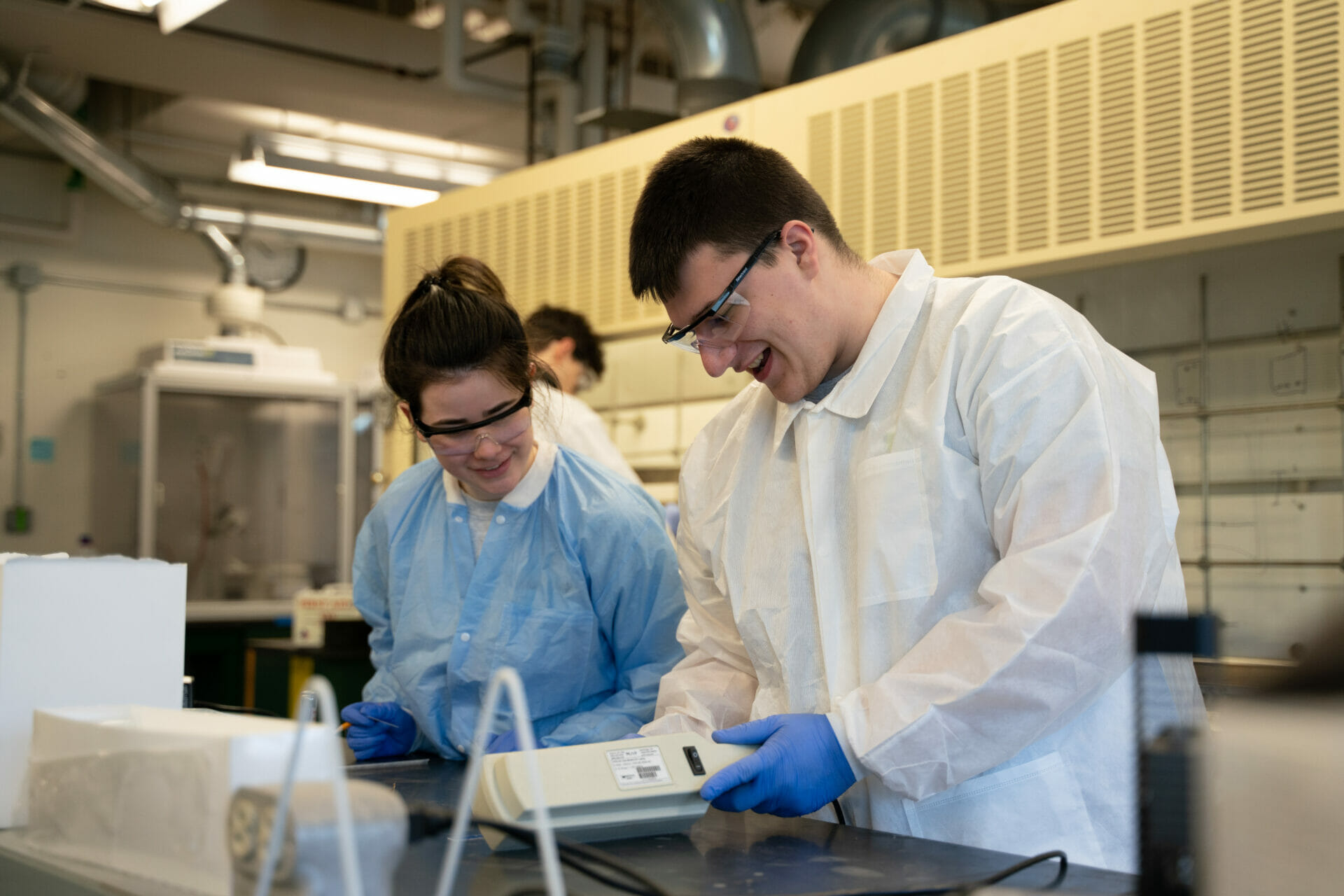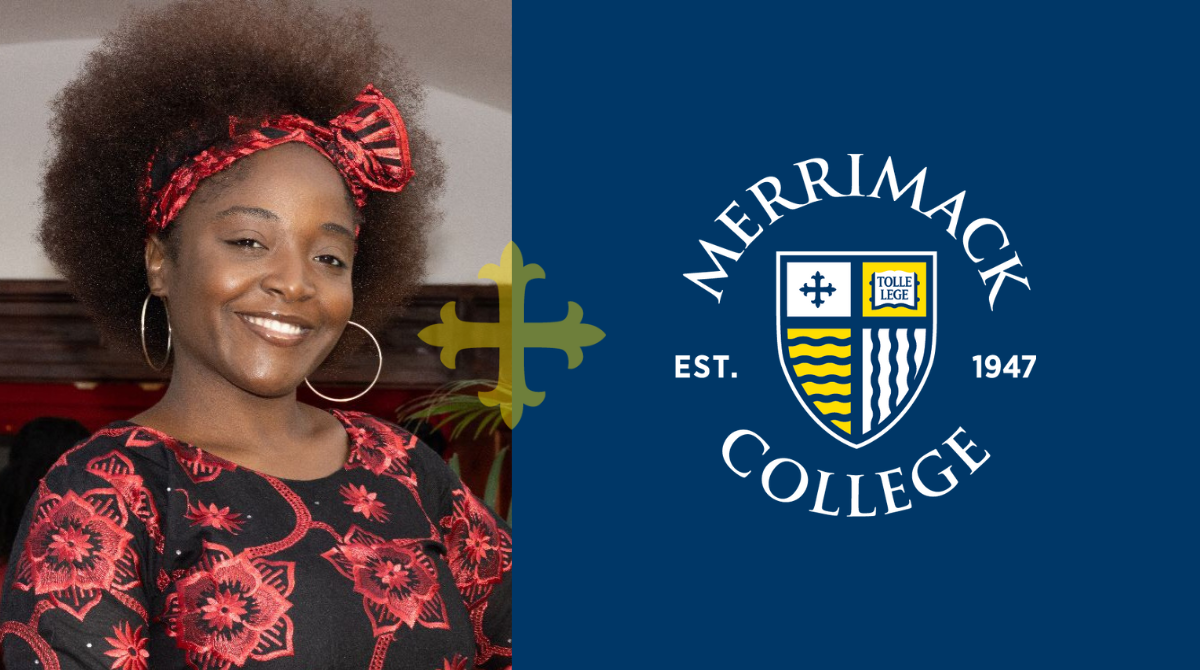Biology Faculty Research
At Merrimack College, the Biology department consists of many experienced faculty members who engage in both private and student-assisted research. Please review their recent research contributions below.






Dr. Charlotte Berkes
The Merrimack River is New England’s second largest surface-based drinking water source. One concerning contributor to pollution in the Merrimack River is the occurrence of combined sewage overflows (CSOs) due to extreme precipitation events, which introduce bacteria of human origin into the river. The aim of this study is to detect and quantify antibiotic resistant bacteria in the Merrimack River. Water samples were collected in Methuen and Lawrence during 2021-2022 and DNA was isolated from microorganisms captured by filtration.
The polymerase chain reaction was used to amplify molecular markers of quinolone resistance (qnrS), sulfonamide resistance (sul2), beta lactamase resistance (bla-TEM), and all bacteria (16S rDNA), and these products were cloned into a plasmid vector. Quantitative PCR was used to determine the absolute concentrations of qnrS, sul2, and bla-TEM in water samples relative to 16S rDNA. Our results showed that levels of antibiotic-resistance genes increase following a CSO event, and remain detectable over extended periods of time, highlighting a potential environmental route by which antibiotic resistance may spread. Future experiments will examine additional antibiotic resistance genes and additional water sources.
Due to the rise of widespread severe fungal infections, expansion of our arsenal of antifungal therapies is greatly needed. Threats such as antifungal resistance continue to grow, inhibiting advancements in treatment options, while unrelenting environmental factors contribute to the increase of fungal infection. Photorhabdus is a gram-negative bacilli bacteria that can be found living symbiotically with entomopathogenic nematodes. Previous work has shown that bacteria in this genus produce a wide variety of antibacterial, antiparasitic, antifungal and other bioactive molecules. Previously, differential screening was performed on many Photorhabdus isolates to identify those demonstrating strong antifungal activity with minimal to no activity against bacteria. Four isolates were selected for further analysis.
The purpose of this study was to optimize antifungal production in selected Photorhabdus isolates, determine the spectrum of activity, and describe the chemical nature of the antifungal molecules. Photorhabdus isolates Y21, Y38, T181 and DSMZ3 were grown in liquid culture at 28C in a variety of culture medias. At 2, 5 and 8 days, supernatants were collected and antimicrobial activity was determined using a spot assay against target pathogens. Our preliminary results show that Photorhabdus isolate Y21 produces a compound inhibiting growth of the yeast Candida albicans but not bacterias: E. coli, S. epidermis, or B. megaterium. The compound resists heat-denaturation, suggesting it is a small molecule. Further testing is required to analyze the antifungal activity of Photorhabdus but preliminary results show promise that the bacteria Photorhabdus could be a potential antifungal treatment.
Dr. William McDowell
Contrary to popular belief, most plastics cannot actually be recycled and do not biodegrade. Instead, if these plastics are improperly disposed of and enter the environment light and physical abrasion will break down larger plastics into smaller pieces called microplastics. Microplastics can be seen in many forms, including:
- Fibers from clothing
- Films on items like candy bar wrappers and saran wrap
- Foams and spheres from styrofoam or industrial production
- Fragments of nondescript origin
To better understand the amount and types of microplastics in aquatic ecosystems, Dr. McDowell is investigating how urbanization has impacted natural waterways, specifically the Shawsheen River. The watershed of the Shawsheen River spans from Concord, MA, to Lawrence, MA. A team of researchers, including graduate and undergraduate students at Merrimack College, collect water samples from eleven different locations throughout the watershed. The researchers then filter the water samples through a 0.45 micron filter, and examine them using a microscope. These filters are viewed using a fluorescence light system that causes plastic particles to fluoresce, or emit their own light. Preliminary results have found that there can be as many as 500,000 plastic particles per liter in some locations, though Dr. McDowell has not yet identified what best explains the variability in plastic abundance in the watershed.
The impacts of microplastic exposure to humans are not well understood, but we know that humans can be exposed to microplastics through direct consumption of microplastics in food or beverages or by inhaling them. Once in the body, they are small enough that they can pass from the alveoli in the lungs into the bloodstream, cross the blood-brain barrier, or even be found in the human placenta.
Globally, sales of bottled water have increased rapidly in the 21st century, and in 2021 it is estimated that a total of 600 billion plastic bottles were used by the bottled water industry. Improper disposal of plastic water bottles can lead to microplastics in aquatic ecosystems, but plastic water bottles can also be a direct source of microplastics for humans as well.
In the Merrimack College Greenhouse located on the top floor of Palmisano Hall, Dr. McDowell is currently staging an experiment which is aided by Biology graduate students in order to examine the abundance of microplastics in bottled water, as well as how that changes over time and with exposure to light. Over the six month experiment, he exposes one group of water bottles to light, one group of water bottles remains in the dark – however, both groups maintain the same temperature-controlled environment. McDowell and his students will continue to track microplastics over time to see whether the abundance of microplastics changes over time, and which group has a larger increase in microplastic abundance.
Dr. R. David McLaren
Dr. McLaren’s research addresses fish behavior, ecology & evolution with particular emphasis on reproduction. This project involves data analysis, write up, presentation, and publication of a body of work that spans multiple years of project development/design, trouble-shooting, experimentation and data collection beginning before the pandemic that McLaren recently resurrected on sabbatical in fall 2022.
The project’s first aim is to assess the mating preferences of wild type female sailfin mollies (Poecilia latipinna) for an unnatural, arbitrary, artificially selected “gold dust” male color variant – a trait cultivated over several decades within the aquarium fish trade and therefore not observed in nature. These experiments are part of a larger on-going effort in Dr. McLaren’s lab to investigate the notion that, like humans, many if not most animals have a “taste for the beautiful” particularly in the context mating preferences.
A second aim of this proposal is to examine the extent to which pre-existing sensory/perceptual biases in female sailfin mollies (P. latipinna) affect their previously documented tendency to copy the mate choice decisions of other “model” females. Evidence of female preferences for males expressing the novel/arbitrary, artificially-selected color variants coupled with a tendency to preferentially copy the mate choices of model females expressing the same novel traits over the choices of more natural-looking wild-type models, would offer strong support to the notion of hidden preferences (i.e., traits/signals with presumably no adaptive value having the capacity to reveal aesthetic preferences manifest as a product of the observer’s subjective sensory/perceptual experience).
Behavioral ecotoxicology is the study of behavioral responses to determine the potential effects of toxicants and other stressors on individuals, populations, and communities (Peterson et al. 2017). SSRIs such as fluoxetine are the most widely prescribed antidepressants in the United States (Gelenberg & Hopkins, 2007). Numerous studies (e.g., Brooks et al., 2003; Kolpin et al., 2002) have indicated that antidepressants including fluoxetine are discharged in municipal wastewater treatment plant effluents and are widespread in surface waters of the United States.
Thus, aquatic animals may be exposed to concentrations of SSRIs, at levels high enough to possibly alter both physiology and behavior. For example, populations of several species of fish living in a municipal effluent-dominated stream reportedly contained concentrations of fluoxetine (as well as other pharmaceuticals) at levels higher than 0.1 ng/g in liver, brain, and muscle tissues (Brooks et al., 2005). Epithelial uptake represents a plausible mechanism for the uptake of environmental contaminants in body tissues of bettas (Foberg, 2003; Foran, et al., 2004). Students will be assisting with this experiment throughout the summer 2023 term.
Dr. Azam Noori
Nanomaterial are used in various products. Despite the benefit they provide in all sections of medicine, industry and agriculture, their high application rates have raised concerns about their impact on the ecosystem and living organisms. Nanoparticles are quite small (ranging from 1-100 nm) and can enter plant cells and the human body through the food chain. This study will focus on nanoparticle’s behavior in plants as well as their interaction with essential nutrients, and their pathways in plants from root to fruit.
This study has been awarded a National Science Foundation grant. Launching this summer, this project will stand as a three-year project with samples being analyzed as soon as fall 2023. This project will involve both undergraduate and graduate students.
Silver nanoparticles (AgNPs) are particularly among the widely used nanomaterials in medicine, industry, and agriculture. The small size and large surface area of AgNPs and other nanomaterials result in their high reactivity in biological systems. To better understand the effects of AgNPs on plants at the molecular level, tomato (Lycopersicon esculentum L.) seedlings were exposed to 30 mg/L silver in the form of nanoparticle (AgNPs), ionic (AgNO3), or bulk (Ag0) in 50% Hoagland media for 7 days. The effects of silver on the expression of plant membrane transporters H+-ATPase, vacuolar type H+-ATPase (V-ATPase), and enzymes isocitrate dehydrogenase (IDH), and catalase in roots was assessed using RT-qPCR and immunofluorescence-confocal microscopy.
There were significantly higher observed expression of catalase in plants exposed to AgNPs (Fold of expression 1.1) and AgNO3 (Fold of expression 1.2) than the control group. The immunofluorescence imaging of the proteins confirmed the gene expression data; the expression of the enzyme catalase was upregulated 41, 216, and 770% higher than the control group in plants exposed to AgNPs, Ag0, and AgNO3, respectively. The results from this study improve our understanding about the molecular effects of different forms of silver on important crop species.

